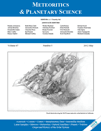
METEORITICS & PLANETARY SCIENCE
metrics 2024
Innovating Insights into Earth and Space Science.
Introduction
METEORITICS & PLANETARY SCIENCE is a premier journal dedicated to the exploration and analysis of celestial bodies, meteorites, and planetary processes, published by WILEY in the United States. With its ISSN 1086-9379 and E-ISSN 1945-5100, the journal spans a rich timeline from 1996 to 2024, providing a vital platform for researchers and professionals in the fields of Geophysics and Space and Planetary Science. Holding a reputable place in the academic community with a Q2 quartile ranking based on the 2023 metrics, it stands out with Scopus ranks of #54 out of 165 for Earth and Planetary Sciences in Geophysics, and #50 out of 104 in Space and Planetary Science, demonstrating its influence and commitment to advancing knowledge in this fascinating domain. The journal also embraces Open Access options, facilitating widespread dissemination of research findings. By fostering interdisciplinary collaboration and sharing innovative research, METEORITICS & PLANETARY SCIENCE serves as an essential resource for those engaged in understanding the complexities of our solar system and beyond.
Metrics 2024
 0.81
0.81 2.20
2.20 2.40
2.40 112
112Metrics History
Rank 2024
Scopus
IF (Web Of Science)
JCI (Web Of Science)
Quartile History
Similar Journals

Journal of Asian Earth Sciences-X
Unlocking the Potential of Asian Earth SciencesJournal of Asian Earth Sciences-X, a distinguished publication by ELSEVIER, is at the forefront of Earth and planetary sciences, particularly focusing on the dynamic fields of geology and earth-surface processes. As an Open Access journal since 2019, it provides unparalleled access to high-quality research, fostering global collaboration and dissemination of knowledge. With an impressive impact factor and ranking in the Q2 category for both Earth-Surface Processes and Geology, it serves as a crucial platform for researchers, professionals, and students alike to share their findings and insights. Situated in the United Kingdom, the journal thrives on contributions that enhance our understanding of Asian geosciences within a broader global context, aiming to tackle major challenges such as climate change and natural resource management. By bridging regional studies with global perspectives, the Journal of Asian Earth Sciences-X is not only a vital resource for academia but also supports sustainable development initiatives across the region.
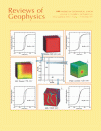
REVIEWS OF GEOPHYSICS
Synthesizing Knowledge, Shaping the Future of Geophysics.REVIEWS OF GEOPHYSICS is a prestigious journal published by the American Geophysical Union, renowned for its critical contributions to the field of geophysics since its inception in 1963. With an impact factor that signifies its scholarly excellence and a Q1 ranking in Geophysics (2023), this journal is the leading platform for disseminating groundbreaking research across Earth and Planetary Sciences, currently holding the top position in its category. As a valuable resource for researchers, professionals, and students alike, it offers comprehensive reviews that synthesize significant advancements and theoretical insights, fostering the exchange of innovative ideas within the geophysical community. Although typically not an open-access journal, its influence is bolstered by its rigorous peer-review process and publication standards, ensuring that each article meets the highest academic criteria. Well-positioned in the heart of Washington, DC, the journal remains an essential reference for those seeking to remain at the forefront of geophysical research developments.
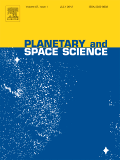
PLANETARY AND SPACE SCIENCE
Innovating Discoveries: Your Gateway to the Universe's SecretsPLANETARY AND SPACE SCIENCE is a leading journal dedicated to the interdisciplinary field of astral studies, encompassing both planetary science and the exploration of space. Published by PERGAMON-ELSEVIER SCIENCE LTD in the United Kingdom, this journal has been pivotal since its inception in 1959, continually contributing to advancements in research about planetary bodies, their atmospheres, and the broader cosmic landscape. With an impressive impact factor, PLANETARY AND SPACE SCIENCE ranks in the second quartile of Astronomy and Astrophysics and the third quartile in Space and Planetary Science as of 2023, showcasing its scholarly significance. The journal aims to provide a platform for the dissemination of cutting-edge research, emphasizing the critical role of space exploration and planetary studies in understanding our universe. Researchers, professionals, and students alike are encouraged to explore the wealth of knowledge presented in its pages, fostering a deeper comprehension of the phenomena that shapes both our solar system and beyond.
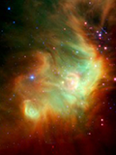
Annual Review of Earth and Planetary Sciences
Synthesizing Insights from Earth to the CosmosAnnual Review of Earth and Planetary Sciences is a leading scholarly journal published by Annual Reviews, dedicated to advancing our understanding of the dynamic processes governing the Earth and its celestial companions. With ISSN 0084-6597 and E-ISSN 1545-4495, this esteemed journal, established in 1976, has consistently provided comprehensive reviews that synthesize cutting-edge research across various disciplines, including astronomy, astrobiology, geology, and planetary science. Notably, the journal has achieved a remarkable position in the academic landscape, ranking in the Q1 quartile across multiple categories, including Astronomy and Astrophysics and Earth and Planetary Sciences, with Scopus rankings placing it at the forefront of these fields. The journal's commitment to facilitating open access to critical scientific advances, though not fully open, allows for maximum reach within the research community. Researchers, professionals, and students alike can benefit from the high-impact articles designed to foster collaboration and innovation within the fields of earth and planetary science.

Planetary Science Journal
Advancing Understanding: Your Gateway to Celestial DiscoveriesThe Planetary Science Journal, published by IOP Publishing Ltd in the United Kingdom, stands at the forefront of research in the fields of planetary science, astronomy, and geophysics. With its open access model established since 2020, this journal aims to democratize access to groundbreaking findings that explore the complex interactions between celestial bodies and their atmospheres, geology, and climates. Recognized for its high quality, the 2023 impact factor places the journal in the prestigious Q1 category across multiple disciplines, including Astronomy and Astrophysics, Earth and Planetary Sciences, and Space and Planetary Science. Ranked favorably among its peers, with notable scores in Scopus rankings, the journal seeks to contribute significantly to advancing our understanding of planetary systems and their formation, encouraging interdisciplinary collaboration among researchers, professionals, and students alike. By fostering a community of innovation and inquiry, the Planetary Science Journal is committed to publishing pioneering research that addresses critical questions of our universe.

SPACE SCIENCE REVIEWS
Advancing Knowledge in Astronomy and BeyondSPACE SCIENCE REVIEWS, published by Springer, is a premier interdisciplinary journal that has been at the forefront of space science research since its inception in 1962. With an impressive impact factor and a distinguished Q1 ranking in both Astronomy and Astrophysics, as well as Space and Planetary Science, it stands as a leading platform for the dissemination of cutting-edge research. The journal encompasses comprehensive reviews covering a diverse array of topics, from cosmic phenomena to planetary exploration, serving as a critical resource for researchers, professionals, and students alike. Although it operates primarily under a subscription model, its commitment to excellence and rigorous peer-review process ensures that each article meets the highest standards of scientific integrity. With its headquarters in the Netherlands, SPACE SCIENCE REVIEWS is positioned strategically to foster global collaboration in the field, making it an invaluable asset for anyone interested in the ever-evolving landscape of space science.
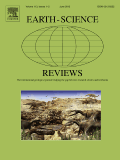
EARTH-SCIENCE REVIEWS
Elevating research with rigorous reviews and impactful studies.EARTH-SCIENCE REVIEWS, published by Elsevier, is a prestigious journal in the field of Earth and Planetary Sciences. With an impressive impact factor and ranked in the Q1 quartile for its category, this journal has established itself as a leading platform for the dissemination of high-quality research and reviews. Spanning topics within general Earth and planetary sciences, the journal provides a unique confluence of interdisciplinary studies, serving researchers, professionals, and students who seek to deepen their understanding and foster advancements in the field. Based in the Netherlands, the journal has been integral to the scholarly community since its inception in 1966, with an ongoing commitment to presenting cutting-edge reviews that propel scientific discussions forward. While it does not offer open access options, its rigorous review process and high-ranking status make it a valuable resource for anyone engaged in earth sciences.
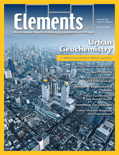
Elements
Illuminating the Complexities of Earth's ProcessesElements is a premier academic journal published by the Mineralogical Society of America, dedicated to advancing knowledge in the fields of Earth and Planetary Sciences and Geochemistry and Petrology. Since its inception in 1973, this journal has established itself as a leading source of impactful research, evidenced by its prestigious Q1 rankings in both categories in 2023, placing it among the top journals globally with Scopus ranks of #18 and #23, respectively. Elements is uniquely positioned to foster interdisciplinary dialogue, offering a platform for groundbreaking studies that explore the fundamental processes shaping our planet. Although it operates without an open access model, its rigorous peer review process guarantees the integrity and quality of published work, making it an essential resource for researchers, professionals, and students eager to stay abreast of the latest developments in mineralogy and earth sciences. With a commitment to excellence, Elements continues to push the boundaries of our understanding of geological phenomena and their implications for both science and society.

EARTH MOON AND PLANETS
Advancing Knowledge in Planetary Science and AstronomyEARTH MOON AND PLANETS, published by Springer, serves as a vital platform for researchers and professionals in the interdisciplinary fields of astronomy, planetary science, and earth sciences. With an ISSN of 0167-9295 and E-ISSN of 1573-0794, this journal has been disseminating knowledge since 1984 and continues to provide valuable insights into the complexities of celestial bodies and their interactions. Although currently ranked in the Q4 quartile across its relevant categories, including Astronomy and Astrophysics, Earth and Planetary Sciences, and Space and Planetary Science, the journal remains committed to fostering academic discourse and innovation in its field. Located in the Netherlands, at VAN GODEWIJCKSTRAAT 30, 3311 GZ DORDRECHT, the journal offers an array of research articles designed to inspire scholarly exploration and collaboration. Despite not providing open access options, it nevertheless plays a significant role in shaping the discourse around planetary research and is essential reading for anyone looking to deepen their understanding of earth, moon, and planetary sciences.

GEOMAGNETISM AND AERONOMY
Exploring Earth's Magnetic Mysteries and Atmospheric WondersGEOMAGNETISM AND AERONOMY, published by MAIK NAUKA/INTERPERIODICA/SPRINGER, is a prominent journal dedicated to advancing the fields of geophysics and planetary science. With ISSN 0016-7932 and E-ISSN 1555-645X, this journal serves as a critical platform for researchers to disseminate their findings on geomagnetic phenomena and aeronomical studies, fostering a deeper understanding of Earth's magnetic field dynamics and atmospheric interactions. Spanning publishing years from 1996 to 2024, it is categorized in the Q3 quartile for geophysics and Q4 for space and planetary science, reflecting its positioning within the academic landscape. Although not open access, readers and researchers can access valuable insights into geomagnetic and atmospheric research, contributing to ongoing discourse in these vital scientific domains. With a focus on innovative research, GEOMAGNETISM AND AERONOMY remains an essential resource for professionals and students aiming to deepen their expertise in Earth and planetary sciences.